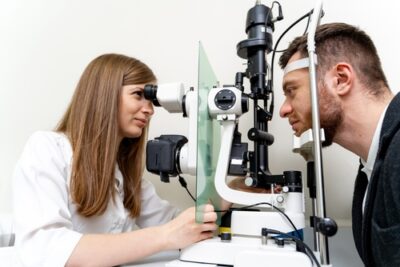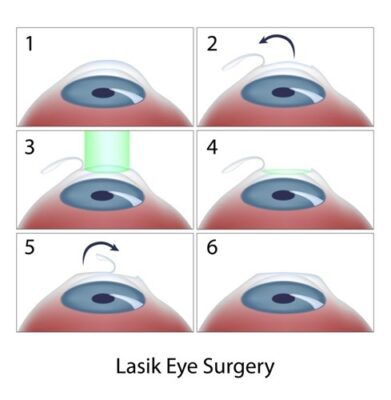Many people who wear glasses or contact lenses have considered getting LASIK but need help figuring out where to start. Some of them may also be apprehensive about undergoing an elective eye procedure.
If you fall into either of these camps, you should know that LASIK is a highly effective, low-risk procedure. Over 95% of patients have 20/20 vision or better after LASIK!
Because LASIK is a minimally invasive procedure with such impressive results, it should come as no surprise that LASIK has high patient satisfaction rates. Although there’s a journey to having LASIK, it’s easy to navigate. Keep reading to learn about the visual journey to having LASIK and why it’s worth it!
How Do I Know If I’m a Candidate for LASIK?

The only way to find out if you’re a good LASIK candidate is to schedule a consultation. But before you can do that, there are a few requirements you can determine for yourself.
LASIK candidates must be over 18 and have a prescription that’s remained unchanged for at least a year. They should also be in good health with no other eye conditions besides a refractive error.
You may be a good candidate if you meet these requirements, meaning you should schedule your consultation. You should still schedule a consultation if you need clarification on whether you meet these basic requirements. Consultations are commitment-free. After having one, you can determine if you’re well suited for LASIK.
What Happens During a LASIK Consultation?

When you go in for your LASIK consultation, you’ll have the opportunity to talk with an ophthalmologist to learn more about the procedure. They can answer any questions or concerns you may have.
They’ll also evaluate you for LASIK. Your evaluation includes a complete eye exam along with several other tests.
Your ophthalmologist will measure your tear quality, corneal thickness, and pupil size. All these tests are essential in determining if LASIK is safe for you to undergo.
Around 85% of patients who undergo evaluation make good LASIK candidates. There’s a good chance that you’ll qualify for LASIK.
If you are a good LASIK candidate, it’s up to you whether you want to undergo the vision correction procedure. You can often schedule your surgery at your consultation, but you can also consider it and decide if you’re ready to have LASIK.
What Happens During LASIK?

LASIK is an outpatient procedure, meaning you get to go home the same day you have it. You’ll remain awake for it, so no general anesthesia is required.
Not using general anesthesia makes LASIK (and other eye procedures) very low-risk because most of the risk associated with surgery is from general anesthesia. Before LASIK, you’ll receive a local anesthetic from eye drops that completely numb your eyes without needing needles.
After numbing your eyes, your LASIK surgeon will create a flap in your cornea. They do this with a femtosecond laser in a process that only takes seconds.
Once the flap is made, you may feel pressure on your eye, which could cause slight discomfort and last a few seconds. After making the flap, it’s lifted, and an excimer laser reshapes the corneal tissue to change the shape of your eye, which corrects any refractive errors.
Thanks to the numbing eye drops, you shouldn’t feel anything during this part of the procedure. Once the excimer laser finishes, the flap is replaced and placed back down, rendering the LASIK procedure complete!
The flap acts as a natural bandage as your eye heals and doesn’t need any stitches to stay in place. It will eventually fuse back to the rest of your eye as it heals.
The LASIK procedure only takes a few minutes per eye. After staying for observation in a recovery room for an hour or so, you can go home to begin recovery.
What is Recovery Like After LASIK?

If you’re worried about an extended or lengthy recovery after LASIK, don’t be. You’ll be back to the things you love before you know it.
Discomfort from the procedure only lasts a day or two. After that, you can go about as usual and only have to follow some rules to protect your eyes for a few weeks.
Protecting your eyes includes:
- Taking prescription eye drops
- Wearing eye shields at night
- Refraining from anything interfering with healing, like wearing eye makeup and heavy exercise
Your eye doctor will give detailed instructions to ensure you know how to keep your eyes safe. After a few weeks, you’ll no longer need to take any more precautions and can live normally.
Technically, your eyes will not fully heal until 3-6 months after having LASIK. But the only thing you’ll notice in this time is your vision improving.
You’ll be able to see improvement immediately after surgery, but it’ll only continue to get better as your eyes heal. When they are completely healed, your vision will have reached its peak.
For most of your recovery after LASIK, all you need to do is look forward to seeing the world with your incredible new vision! What’s easier than that?
Benefits of LASIK

Getting LASIK and recovering from it couldn’t be more straightforward. You’ll only experience a small amount of discomfort and downtime, and you can have the vision of your dreams in exchange.
You can also finally achieve total freedom from glasses and contact lenses! Many patients find LASIK is well worth getting for visual freedom alone. But because 96% of patients achieve 20/20 vision or better, chances are also very high that you’ll be able to see better than you ever could, even with contacts or glasses!
Between incredibly crisp vision and eliminating the need for traditional visual aids, LASIK is undoubtedly worth the journey. If you’re ready to take your first steps on your visual journey, schedule your consultation today at Sugiki Portis Eye Center in Honolulu, HI! Isn’t it time to invest in something better, like your vision?





